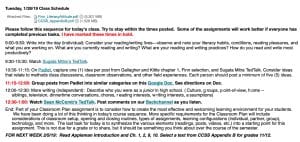Finding a Space for Teaching
When the partnership began, it was more of an agreement for teaching space. After a semester of using a high school classroom and engaging in a few opportunities that being in a high school presented, the division chair and I planned more intentional experiences for the candidates and mentor teachers.
Adding Instructional Topics
In the fall, a teacher presented on the learning management system, demonstrating a number of features this tool provides such as seating charts, student schedules, and mail merge emails. To enhance our discussion of assessment, the division chair guided us through an analysis of a test: its format, the student responses, most-missed questions, and next steps for instruction.
Planning Intentional Experiences
At the end of the fall semester, we surveyed the mentor teachers and collected Student Evaluations of Instruction for feedback that would help us plan for the spring. This chart captures some of these findings and shows next steps for the spring semester.
| Spring 2018 SEI (4.0 or below) and comments | Spring 2018 Mentor Teacher Feedback | Fall 2018 SEI (4.0 or below) and comments | Fall 2018 Mentor Teacher Feedback | Spring 2019 Next Steps |
| Policies of the course on such matters as grading, absence from class, schedule of assignments, etc., were stated at the beginning of the semester included in the syllabus or communicated through some other communication method. | More information about candidate’s role for implementation in the classroom | The instructor’s communication was clear and expressive (e.g. instructor provided clear examples). | There were times when I had two teachers at once and then I wouldn’t see one of the candidates for a couple weeks. I felt that parts were a little unorganized and not consistent. | Send email to mentor teachers discussing feedback from Fall 2018, detailing objectives for Spring 2019, explaining task list for field experiences, and assigning candidates. |
| reading material was interesting, except maybe the book on reading lenses. Some of the links were not available and I think it made the lenses seem more complicated than they were. | The readings were helpful, but provide more opportunities for teaching in front of classes. | In-class presentations will help prepare candidates for microteaching, but more analysis of real teaching in real time needs to be implemented. |
Additional notes included lengthening the time for mentor teacher and candidate interactions and providing more opportunities to present or teach in front of a class. Feedback from candidates and mentor teachers informed our planning for the spring semester. It is our hope that consistently asking for feedback and responding to it will develop trust among stakeholders in this partnership.
